The Holy Sepulcher
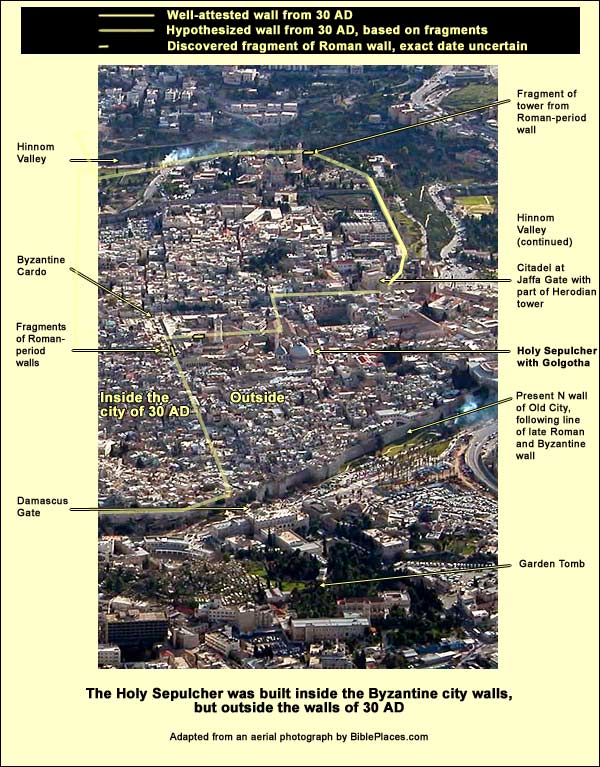
And here is an alternative view from the northwest.
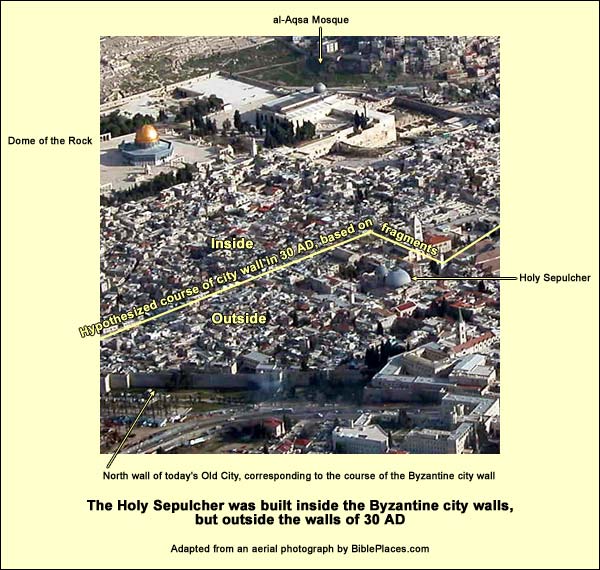
Helena did not choose an ordinary spot. The place contained a pagan temple, built by the Emperor HadrianPublius Aelius Hadrianus (76 – 138 AD). Roman emperor from 117 until his death. He quelled the Bar Kokhba revolt, the second major Jewish uprising in the land. After banishing the Jews from Jerusalem, he rebuilt the city, naming it Aelia Capitolina. He is also remembered as the builder of Hadrian's Wall in northern England., which had been Jerusalem's holiest site for 200 years. Our sources on Hadrian's activities are so obscure, questionable and contradictory that we cannot be certain which god was adored here. Some say Venus, others Jupiter, still others a trio of gods. But it is a long-established pattern in this country, that a newly victorious religion usurps the holy place of its predecessor. If Helena had no strong tradition about the location of Jesus' grave, then perhaps in a gesture of Christian triumph, she decided to build on the pagans' holiest spot! To clarify our thinking, we may start with two opposing versions of what may have happened.
1. Hadrian built his Temple where he did in a place that was sacred to Christians, either because holiness had accrued to the site or because he wanted to cover it over. When Helena arrived, the local Christians remembered where the grave had been. They dug through Hadrian's platform and found it. Thus wrote Eusebius of Caesarea in the 4th century.
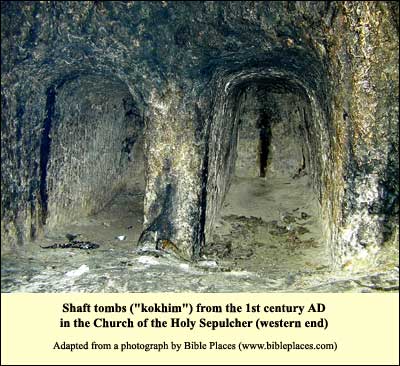
2. Hadrian built his Temple in the place designated by the Roman augurs. Helena, in a gesture of triumph, decided to rip it down. Tombs were discovered, and one was singled out as that of Jesus.
Jerusalem has long been surrounded by tombs. It is not extraordinary that Helena's builders found some. Interesting, however, is the fact that the tombs were precisely of the first-century type. Some are still visible in a small, smoke-blackened chapel due west of the official grave. They are body-length shafts cut back into the rock. The practice was to keep the corpse in such a shaft, closing this off with a slab. A rolling stone would shut the entire cave. After a year, relatives came and removed the bones, placing them in an ossuaryAmong the wealthy, from 40 BC till 135 AD, burial occurred in two stages. Relatives laid the body in the shaft, closing it. A year later the relatives returned and found only bones. They gathered these and placed them in a stone box called an ossuary (big enough to include the femur), which they put with those of the ancestors in the center of the chamber. Now they could re-use the shaft. Sometimes the sides of ossuaries are inscribed with the names of the dead. Among the names found in graves around the city, for example, were Yeshua (Jesus), Simon, Miriam (Mary), Martha and Eleazar (Lazarus), all common names at the time. Several may be seen at the Israel Museum. Among these is one with the name Yosef Bar Kafatz (Joseph Caiaphas) – not a common name!. Thus they re-used the shafts, while assembling the ossuaries in the cave.
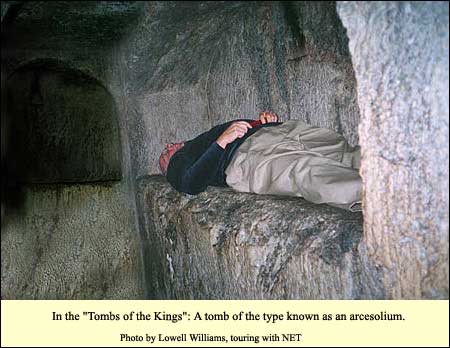
The grave identified as that of Jesus is a slight distance away. The holy tomb that we see today is a replica, for the original was destroyedDestruction of the Holy Sepulcher (1009): Al-Hakim assumed the throne of Islam in 996 AD. He started his reign by showing the tolerance toward Jews and Christians that had typified the caliphs before him. For unknown reasons, however, in 1003, he undertook a program of destroying churches. At the Holy Sepulcher, his team hacked the tomb to pieces, as well as the rock of Golgotha. What we see today is only part of that rock. As for the tomb, it is a replica. The memory of al-Hakim's behavior became a motive for the Crusades.. From a description by ArculfA Gallic bishop with a strong interest in architecture. He visited the Holy Land around 680 AD, bringing back sketches of buildings and descriptions of landscape., however, we know that the original was an arcosoliumA recess cut in the wall of a burial cave, consisting of a bench for the body and an arch over it. This form was used from the 1st century BC until the 5th AD., a form also common at the time of Jesus' Passion. The 1st-century tombs in the Holy Sepulcher give weight to the claim for the site's authenticity. Moreover, why did Hadrian choose this spot? To say "the augurs" seems insufficient. When Hadrian conquered Jerusalem, there were two groups here, Jews and Christians (many of whom were converted Jews). He may have built another temple on the holy place of the Jews -- or he may have avoided it, playing its sanctity down. (Three 4th-century pilgrims mention statues, including Hadrian's, at the site of the former Jewish Temple, but no eye witness mentions a Roman sanctuary.) We do know, however (from archaeology, as well as Eusebius) that Hadrian did build a temple where the Church of the Holy Sepulcher stands today. Since this spot was nothing to the Jews, to whom would it have been something? To the other main group in Jerusalem. Not that Hadrian was anti-Christian: he wasn't. But a holy place is a holy place. This consideration may have influenced the augurs' advice about where the Emperor should build. The same sort of thing happened elsewhere. In Bethlehem (on this point the historical sources are clear) the Romans established a "grove of Adonis" above the cave where Christians had earlier remembered Jesus' birth, and which they later included in the Church of the Nativity. The evidence tilts toward the authenticity of the Holy Sepulcher. Here, quite likely, Jesus was buried. {mospagebreak title=History} History of the Holy Sepulcher Archaeologists have investigated sections beneath the floor of the present building. During the First Temple period, the area served as a quarry. By the time of Jesus' Passion, families had dug tombs into its cliff, although one outcropping of stone remained. We can see the top of this outcropping today in the Chapel of Calvary (Golgotha), or, below, we can see it from its side in the Chapel of Adam. The latter view reveals bedrock that seems of poor quality. Perhaps for this reason the ancient quarriers left it alone.
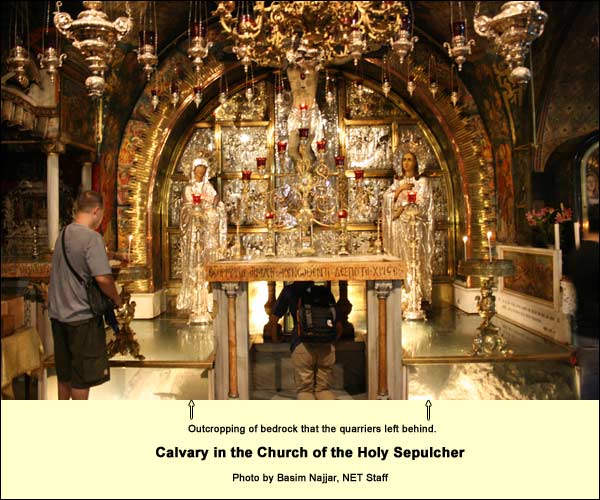
Over the quarry HadrianPublius Aelius Hadrianus (76 – 138 AD). Roman emperor from 117 until his death. He quelled the Bar Kokhba revolt, the second major Jewish uprising in the land. After banishing the Jews from Jerusalem, he rebuilt the city, naming it Aelia Capitolina. He is also remembered as the builder of Hadrian's Wall in northern England. raised a temple. When Helena visited in 325 and her workmen tore it down, they found, beneath the floor of its platform, a grave which they identified as that of Jesus. They cut away the stone around it, including other graves, and built a rotunda with a golden dome, which they called the Anastasis (Resurrection). To the east of this was an open court. Against its eastern wall stood the rock of Calvary, higher than today. Farther east they built a basilica, called the Martyrion, with a triple gate and steps leading down to the CardoThe Cardo was the main north-south street in Roman urban planning, the "hinge" on which the life of the city revolved.. The whole church was 423 feet by 146 (at its widest place, the rotunda). We can find its main elements on the Madaba mapA church at Madaba, today in Jordan, goes back to Byzantine times. In the 19th century, a mosaic floor was uncovered, dating to about 580 AD. It contains a pilgrim's map of the entire country, including Jerusalem.:
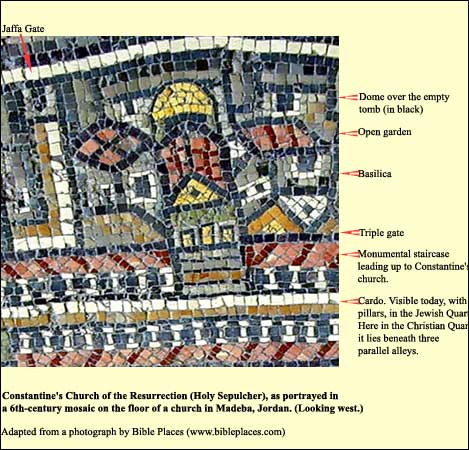
This was the building the Muslims saw when they conquered Jerusalem in 638. The Persians had damaged it in 614, but its splendor still raised sufficient concern in Muslim hearts that they built the Dome of the Rock as a rival, copying the size of the dome to within an inch. Legend has it that the Bishop invited Umar, the Muslim conqueror, to pray in the church, but he declined, saying that if he did so, his co-religionists would later take it over, saying, "Umar prayed here." Instead, he prayed just south of the church, in what is today the Mosque of Umar (not to be confused with the Dome of the Rock, sometimes mistakenly called that). (Digression on mosques beside churchesIn some places a mosque has replaced a church (as at the site of the patriarchs' graves in Hebron and at the site of Jesus' Ascension on the Mt. of Olives); elsewhere we often find a mosque built beside a church, as at the Holy Sepulcher or in Bethlehem. Nazareth was once an exception, because it was an almost entirely Christian town until 1948. An influx of Muslim refugees during the war of that year set change afoot. Today the city has more Muslims than Christians, and some among the former seek to build a mosque beside the Church of the Annunciation..) The great destruction came in 1009. The Caliph al-HakimAl-Hakim (996-1021). Fatimid Caliph who ruled the Muslim world from Egypt, waging a relentless campaign to convert his Christian and Jewish subjects to Islam. In 1016, convinced of his own divinity, he led his followers out of Islam into a new religion, whose members are known as Druze. He disappeared in Cairo in 1021. Non-Druze believe he was murdered. Druze believe he went into hiding and will return to redeem and rule the world. sent a team to level the church. It did not stop at the sacred tomb, but hacked it to pieces, as well as the rock of Golgotha. What we see today is only part of this rock. As for the tomb, it is a replica. The memory of al-Hakim's behavior became a motive for the Crusades.
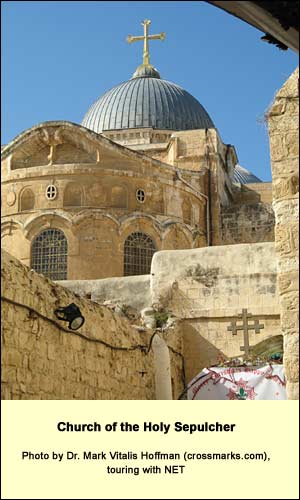
After al-Hakim's mysterious disappearance in 1021, his son restored normal relations with Jerusalem's Christians, allowing them to build. The Byzantine Emperor Monomachus, sent money. They reconstructed the tomb and its rotunda, adding an apse on the east and replacing the earlier dome with a conical one. They enclosed what remained of Golgotha in a separate building. Between Golgotha and the rotunda was an open court. That was all. The relative smallness reflected a smaller community. During the persecutions of al-Hakim, many Christians here and in Egypt had converted to Islam. This was the church the Crusaders found in 1099 and dubbed the Holy Sepulcher. They opened the rotunda on the east and covered the court with a roof, on which they placed a second dome. They also included Golgotha. One entered from the south. Later they added a convent for their clergy east of the church and a bell tower south of the main dome. The result was, in essence, the church as we see it today. Yet only "in essence." In 1808 a fire destroyed the domes and weakened the structure. The dome over the tomb has been replaced several times. Fearing collapse, the Greek Orthodox added inner walls to support the Crusader roof. As a result, instead of the former spaciousness, one has the feeling of a maze. The interior is a hodgepodge of styles in art and architecture, reflecting the repairs, at different times, of the various Christian communities that have rights over different sections . Despite the mix, the church has power, especially if we visit before it gets too crowded. The best time is the first thing in the morning.
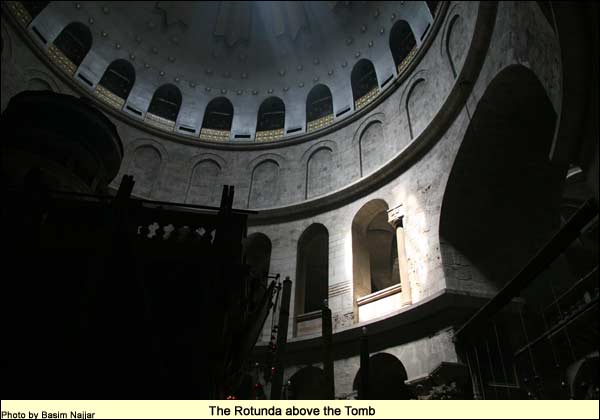
{mospagebreak title=Christian communities}
The Christian Communities in the Holy Sepulcher
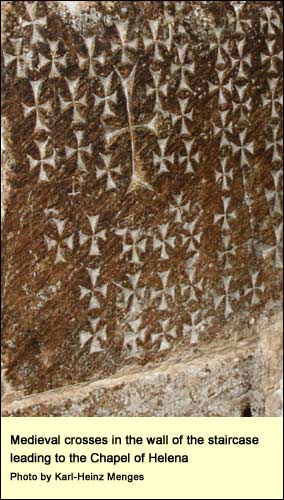
Before the Crusades, when Jerusalem was under Islamic rule, the Muslims permitted the Byzantine clergy to control the Church of the Holy Sepulcher. This clergy was mainly Greek. When the Crusaders conquered the city in 1099, Franciscans from the West ("Latins") took over the church. They stayed in power until Saladin re-conquered Jerusalem for Islam in 1187.
At the behest of the Byzantine Emperor, Saladin allowed the Greek clergy back to the church. In a treaty with Richard the Lion-Hearted, he let the Latins back too. He gave the Copts of Egypt the convent on the roof.
This was just the beginning of a long struggle for rights, interrupted when Khwarismian Turks massacred all the clergies in 1244. Under the Mamlukes, order was restored, and the Christian communities resumed their strife. At one point there were seven groups: the Greeks, the Latins, the Armenians, the Copts, the Ethiopians, the Syrian Orthodox and the Georgians.
The chief method for establishing rights was to use connections with the ruling power or, if necessary, create such connections by bribery. When the Ottoman Turks took Constantinople in 1453, putting an end to the Byzantine Empire, the defeated Greeks came into an advantage over the other denominations: the Greek Orthodox (heirs of Byzantine Christianity) made up a large part of the Ottoman Empire, dominating its civil service. Converts from Greek Orthodox Christianity to Islam composed the army of Janissaries, on whom the Ottomans depended.
The Ottoman Sultan granted decrees favoring the Greek Orthodox. The last, in 1757, established what would henceforth be referred to as the status quo. In a treaty of 1774, he allowed Russia to assume protection over all his Orthodox subjects. His treasury grew apace.
The Georgians, unable to keep up the bribes, left Jerusalem altogether. The Ethiopians wound up on the roof of the church. The Copts managed to keep a monastery there, as well as the foot of Jesus' grave. The Syrian Orthodox got the use of an apse to the west of the rotunda (where 1st century graves may be seen). The Armenians received the Chapel of Helena and another in the gallery of the rotunda. The Latins managed to secure several sections, including the Chapel of Mary Magdalene and that of the Finding of the Cross. As at the Church of the Nativity in Bethlehem, the Greek Orthodox received the lion's share, including the tomb, the Crusader choir, and Golgotha.
In 1831, Muhammad Ali, a breakaway Ottoman commander ruling from Egypt, sent an army into Palestine and managed to hold it for nine years, instituting progressive reforms. Only with the help of the British and French did the Turks get the country back. This marked the entry of the European powers, who took a new interest in the Holy Land. Challenging the Russian guardianship over the holy places, the French in 1852 got the Sultan to issue a decree favoring the Franciscans. Russia responded by occupying two Ottoman vassal states. The Turks declared war. Seizing this chance to limit Russian expansion, the British and French (and Sardinia) joined the Turks.
When this "Crimean War" was over (1856), Russia had lost its dominant role in southeast Europe. The Turks gave their Western allies concessions in Palestine. For example, the HaramHaram es-Sharif, Arabic meaning "the Noble Sanctuary." This is the Muslim term for the area containing the Dome of the Rock and the al-Aqsa Mosque. Jews call it the Temple Mount. was opened to Christians and Jews for the first time in centuries, and the French got St. Anne's Church, which Saladin had made into a Muslim school. In the disputed holy places, however, the Turks re-affirmed the status quo ante bellum. It is best symbolized by a weathered wooden ladder above the entrance to the Church of the Holy Sepulcher. This appears in photographs from the 19th century, exactly in the same spot. It is unclear who has the right to move it.
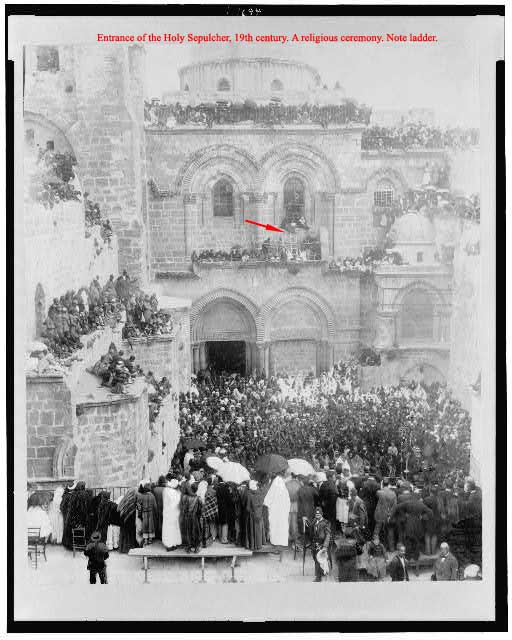
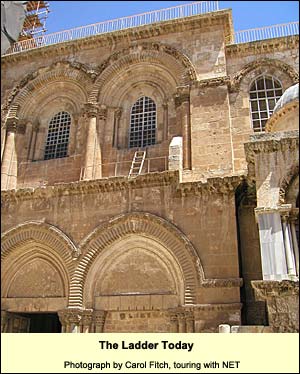
{mospagebreak title=Visit} A Visit to the Holy Sepulcher
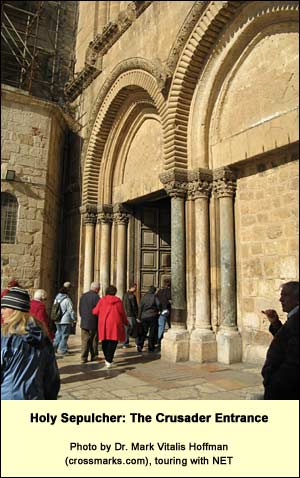
We stand in the courtyard before the double gates. Saladin filled in the one on the right. Two Muslim families have had the right to open the left-hand gate since 1246. They do so, together with one or more of the sextons, in a daily ceremony at 4 a.m. The sextons close the door again a quarter hour after sunset. Still outside, to the right of these doors, a flight of steps leads up to the Tenth Station, where we remember the soldiers dividing Jesus' clothes (Mark 15:24Crucifying him, they parted his garments among them, casting lots on them, what each should take. ). We enter. At once, on the right, is a staircase with very high steps, leading up to Calvary. Here are two altars. The Latin one, on the right, marks the Eleventh Station, and the story is told before us in a mosaic: Jesus is nailed to the cross. The left-hand altar, Greek Orthodox, stands at the Twelfth Station: the place where, according to tradition, the cross was set in the rock. The rock is exposed all around it. Between these two large altars tradition locates the Thirteenth Station, the taking down of Jesus from the cross (John 19:38After these things, Joseph of Arimathea, being a disciple of Jesus, but a secret one for fear of the Jews, asked of Pilate that he might take away Jesus' body. Pilate gave him permission. He came therefore and took away his body.). The place is marked by a smaller altar, dedicated to Our Lady of Sorrows.

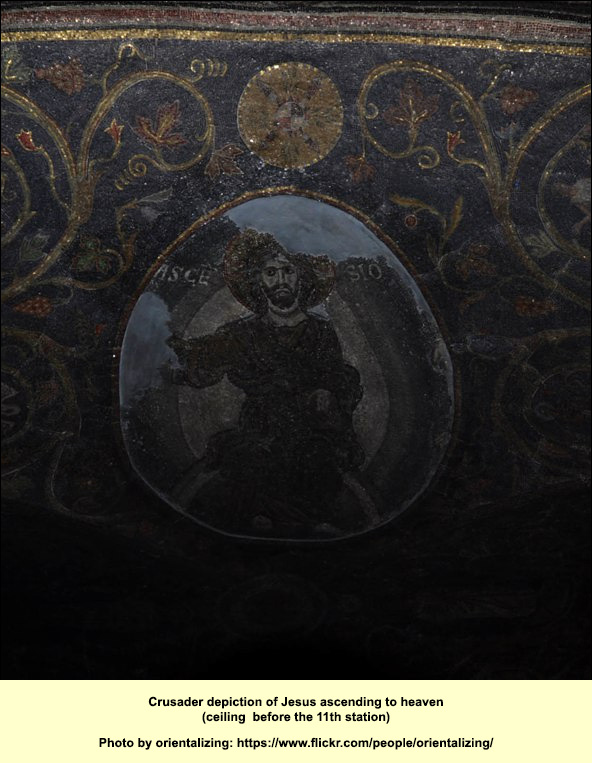
Having taken time here, we descend by the staircase opposite the one we came up on. On our left is the Stone of Unction. Here, since medieval times at least, tradition has located the anointing of Jesus' body before burial (John 19:39-40John 19:39-40:Nicodemus, who had first come to Him by night, also came, bringing a mixture of myrrh and aloes, about a hundred pounds weight. So they took the body of Jesus and bound it in linen wrappings with the spices, as is the burial custom of the Jews.). The new mosaic behind the stone (1991) depicts the account till the burial.
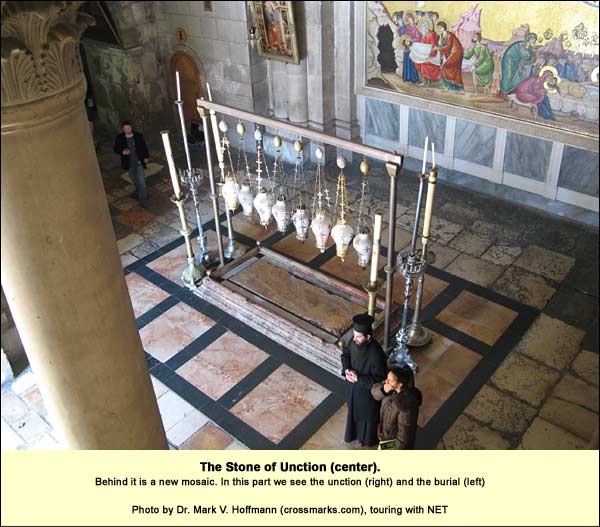
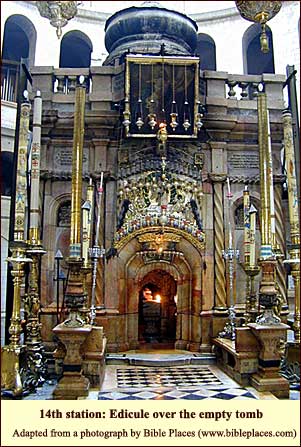
From here we proceed to the Fourteenth Station, the tomb. The original was destroyed,as saidDestruction of the Holy Sepulcher (1009):Al-Hakim assumed the throne of Islam in 996 AD. He started his reign by showing the tolerance toward Jews and Christians that had typified the caliphs before him. For unknown reasons, however, in 1003, he undertook a program of destroying churches. In 1008, al-Hakim sent a team to destroy the Holy Sepulcher. They did not stop at the sacred tomb, but hacked it to pieces, as well as the rock of Golgotha. What we see today is only part of that rock. As for the tomb, it is a replica. The memory of al-Hakim's behavior became a motive for the Crusades., and this is a replica. While we wait, note the large chamber to the east. Today the Greek Cathedral, it was the Crusader choir and before that an open porch, beyond which Constantine's basilica stretched to the east. For decades the area of the tomb was steeped in gloom, because the inner dome was masked by scaffolding. At last the Christian communities reached agreement on a design, and today we have an opening to the heavens, bringing light to the tomb, and bringing to mind the theme of Constantine's original church -- Anastasis, Resurrection. We enter the tomb. The first chamber is the Chapel of the Angels (Luke 24: 1-9But on the first day of the week, at early dawn, they and some others came to the tomb, bringing the spices which they had prepared. They found the stone rolled away from the tomb. They entered in, and didn’t find the Lord Jesus’ body. It happened, while they were greatly perplexed about this, behold, two men stood by them in dazzling clothing. Becoming terrified, they bowed their faces down to the earth. They said to them, “Why do you seek the living among the dead? He isn’t here, but is risen. Remember what he told you when he was still in Galilee, saying that the Son of Man must be delivered up into the hands of sinful men, and be crucified, and the third day rise again?” They remembered his words, returned from the tomb, and told all these things to the eleven, and to all the rest.). The pedestal in the middle is believed to contain a fragment of the original rolling stone. The next chamber is the Sepulcher itself. On the right is a marble slab, marking the place for the body. In consideration of people who may be waiting outside, one should limit oneself to three minutes. Having thus completed the stations, we can go into the small chapel west of the tomb. Through an opening (and with the help of a flashlight or candle) we can make out shaft tombs which date to the period of the Passion, forming a vital part of the argument for the site's authenticity. Then we may go to the Franciscan section north of the tomb. If the Chapel of Mary Magdalene is available, we enter it. If not, we can sit just outside. Either place is good for reading the passage about Magdalene's encounter with the resurrected Jesus. We continue east and descend the steps to the Chapel of Helena. The new mosaic floor shows the most important Armenian churches, as well as Mt. Ararat with Noah's Ark. To the southeast, a small flight of steps leads into a cistern, where Helena (the Crusaders believed) found the true cross. This too is often a quiet place, where we may read and consider. Ascending to the main level, heading around to the west, we find a chapel with a small, illuminated window. Through it we can see a bit of the rock of Calvary, cracked. It is the Chapel of Adam. An Eastern tradition holds that the blood of the last Adam trickled through the earth, making contact with the skull of the first, whose sin he had redeemed.
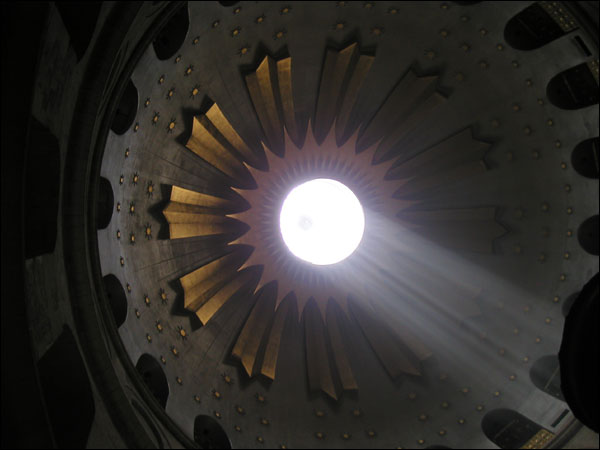
Photo by Carol Fitch, touring with NET. {mospagebreak title=Logistics} Logistics for a Visit to the Holy Sepulcher Modest dressShoulders covered, legs covered below the knees. is required. Men should doff their hats. Opening hours: from 04:00 until 15 minutes after sundown. To double-check on the opening hours, call the Christian Information Center, Monday-Friday before 13:00. Phone: (02) 6272692. On Greek Orthodox holidays in particular, the church may be extremely crowded. To check on holidays, visit the Interfaith Calendar. There are usable rest rooms in the church.
You can best feel the power of this site if you visit in the early part of the morning, planning to finish by 9 a.m., when the crowds begin to arrive. Toward evening the church can be extremely crowded.